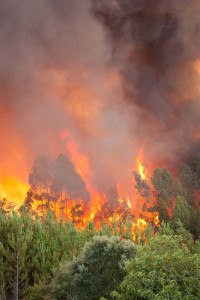The raging wildfire in Alberta, Canada, has prompted concerns in the U.S. that this wildfire season will be as bad as last year. In 2015, there were more than 68,000 wildfires in the U.S. making it one of the worst wildfire seasons on record, according to the National Interagency Fire Center. Total firefighting costs for the year topped out at $2.1 million.
While the summer 2016 wildfire outlook is expected to be less severe than last year, officials are continuing a proactive approach to reduce home wildfire hazards.
 The wildfire outlook report issued by the NIFC Predictive Services for the period of May through August, 2016, indicated an above normal wildfire potential for the Southwest region of the nation. Because of expected above normal moisture in the central US, the fire risk for that area is reduced through the summer months.
The wildfire outlook report issued by the NIFC Predictive Services for the period of May through August, 2016, indicated an above normal wildfire potential for the Southwest region of the nation. Because of expected above normal moisture in the central US, the fire risk for that area is reduced through the summer months.
Despite a less severe than normal outlook, the National Fire Protection Agency and Firewise Communities continue to educate homeowners on what they can do to reduce their wildfire risk.
The Firewise Communities Program was created in 1986 to address some factors that put homes at a higher risk for damage or destruction during a wildfire. These factors include:
- Leaves and debris;
- Dead vegetation;
- Flammable or combustible materials, like firewood stacks and propane tanks.
The home ignition zone, an area up to 200 feet area surrounding and including the home, is a concept developed by a US Department of Agriculture Forest Service fire scientist in the 1990s. The concept offered insight into understanding how radiant heat spur home fires. As a wildfire encroaches near homes, dead plants and debris can heat up and ignite allowing a fire to move even closer to the homes.
The Firewise program utilizes the zone concept in order to reduce flammable vegetation while increasing water content for the remaining landscaping. The zone may be larger than 200 feet if the home is located in a high risk wildfire area. There are three zones within the area surrounding a home:
- Zone 1 includes the area around the entire building and includes all attachments, like fencing and decks, for at least 30 feet in all directions.
- Zone 2 includes the area that is 30 to 100 feet from the home.
- Zone 3 is the area surrounding the home that is 100 to 200 feet.
A demonstration conducted by the Insurance Institute for Business & Home Safety in 2011 examined the causes of building fires during a wildfire and found the three main exposures to be burning embers, direct flame contact and radiant heat.The IBHS found that if vegetation management practices and defensible space zones are in place than radiant heat exposure is less likely to occur.
To inspire more homeowners to reduce their property’s wildfire hazards, the NFPA held the 2016 Wildfire Community Preparedness Day on May 7. The third annual event was sponsored by State Farm and offered project funding in 36 states to cover a variety of risk reduction projects across the nation.
In addition, a number of insurers offer wildfire mitigation programs to high net worth homeowners.
PURE’s program offers preventative services, including a partnership with a wildfire mitigation vendor and use of a fire retardant, as well as emergency response services.
AIG offers a wildfire protection unit to its Private Client Group members.
Last year, Scottsdale-based Crestbrook Insurance Co., launched Crestbrook Wildfire Solution Program in collaboration with Wildfire Defense Systems (WDS), an insurance wildfire loss prevention and response company.
The program gives policyholders in Arizona, California, Colorado, Texas, Oregon and Washington access to risk mitigation and suppression at no additional cost. Services include on-site risk inspection, active fire monitoring, fire education and fire patrols.
Was this article valuable?
Here are more articles you may enjoy.

 As Trump Considers Auto Tariffs Pause, Parts Exemptions Could Be Key for US Industry
As Trump Considers Auto Tariffs Pause, Parts Exemptions Could Be Key for US Industry  Survey Shows Distracted Drivers Overconfident: 20% Text While Driving, 15% Use Social Media
Survey Shows Distracted Drivers Overconfident: 20% Text While Driving, 15% Use Social Media  Merck Faces Patent Lawsuit Over Easier-to-Use Keytruda
Merck Faces Patent Lawsuit Over Easier-to-Use Keytruda  Forecast Calls for Wildfires to Burn More Land Across U.S. This Year
Forecast Calls for Wildfires to Burn More Land Across U.S. This Year 